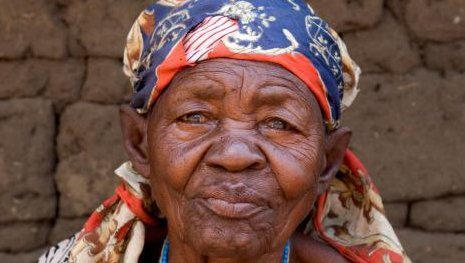(Lauren Sammon)
KAMPALA, Uganda (GPI)-- Karmela Kasule, 54, waddles through her two-room mud-and-wattle house, steaming cornmeal and water to make “posho” for her family. She winces after gripping the hot saucepan with her bare hands.
Kasule heads a household of 22, including her daughter, Ayu Alali, 37, her niece and 19 grandchildren. Gray hairs cover her head, deep scars mark her face, and she barely retains her sight and hearing.
She lives in Acholi Quarters, a densely populated and poorly ventilated camp for internally displaced people near Kampala, the capital.
Women sit close to filthy gutters on verandas of closely built mud-and-wattle structures, carving beads out of paper. Children’s laughter filters through the air. The men drink, play board games and heckle passing women.
Acholi Quarters, located in south-central Uganda, is considered a safe haven for many Acholi people who fled from conflict in northern Uganda.
Kasule says she first fled her home in Palabek, a town in northern Uganda, during the late 1970s from the dictatorship of Idi Amin, Uganda’s third president who seized power in a military coup in 1971 and ruled until 1979. He became known as “the Butcher of Uganda” for his brutal rule. Human rights groups estimate that as many as 500,000 people were killed during his regime.
Kasule stayed in Kampala because Joseph Kony, the rebel leader of the Lord’s Resistance Army, a guerrilla group in Uganda, began terrorizing the north during the mid-1980s. T he International Criminal Court indicted Kony on charges of war crimes and crimes against humanity in 2005, but he remains at large.
“I was already running from Idi Amin Dada’s terror in 1978 when [Kony] murdered my first husband,” she says. “Running away from the insurgency of Kony was just another race for my life. This is my life. I consider myself lucky!”
Kasule says she bore six children in Palabek – two daughters and four sons – but lost all but one daughter to Kony’s war or to HIV and AIDS. One of her sons, David Nyeko, was in seventh grade when the Lord’s Resistance Army killed him in Palabek in 2001 during a clash with the Uganda People’s Defence Force, the country’s armed forces.
The rebels forced Kasule’s only surviving daughter to join their ranks.
“I was forced to cook for the rebels as I watched them slay my brother and rape my community,” Alali says.
Kasule watches silently as Alali struggles to contain the pain on her face.
“I cannot go back to that place,” Alali says of Palabek.
Although most of Uganda’s camps for internally displaced people have closed, many women living in Acholi Quarters say they refuse or can’t yet return home to the north, where they watched rebels slay their family members. A scandal during October 2012 involving the misappropriation of funds by the Ugandan government has hampered its Peace, Recovery and Development Plan. The region still lags behind the rest of the country in key socio-economic indicators, such as housing, health care and education.















